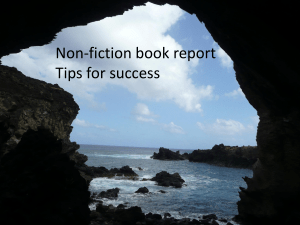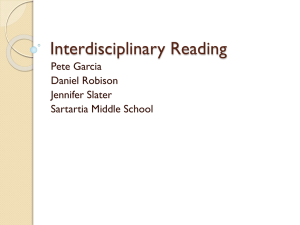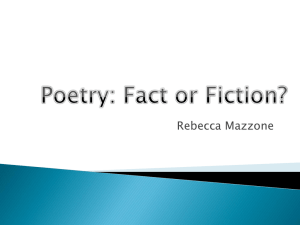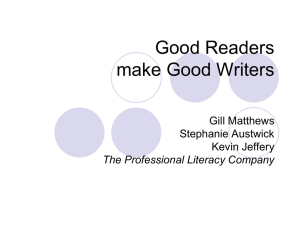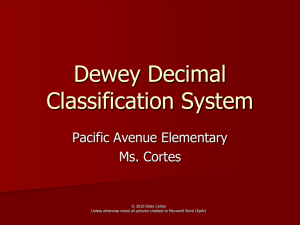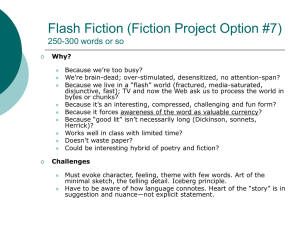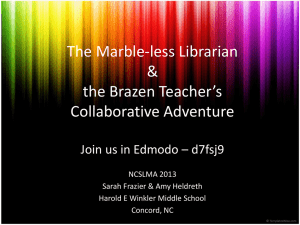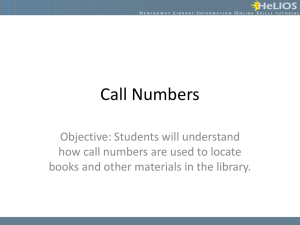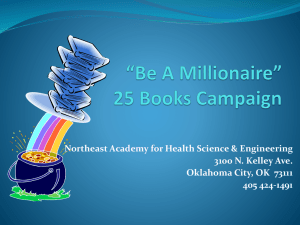Non-fiction - Education - Cambridge University Press
advertisement
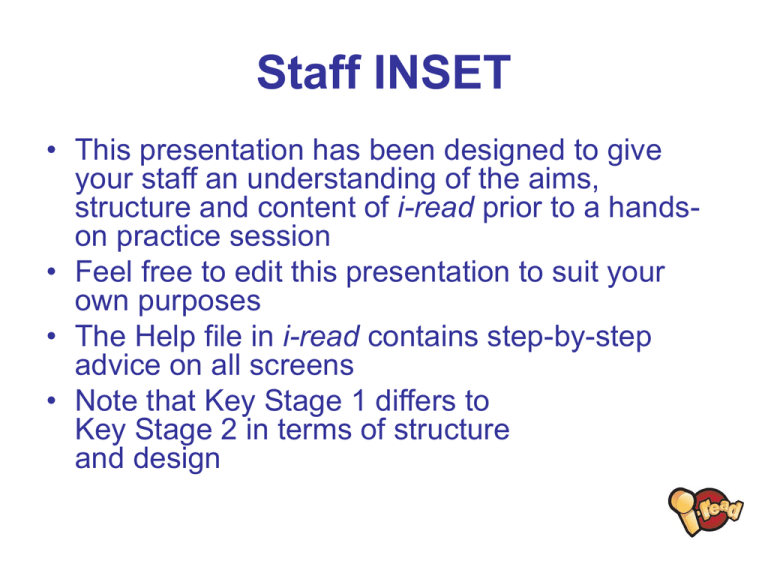
Staff INSET • This presentation has been designed to give your staff an understanding of the aims, structure and content of i-read prior to a handson practice session • Feel free to edit this presentation to suit your own purposes • The Help file in i-read contains step-by-step advice on all screens • Note that Key Stage 1 differs to Key Stage 2 in terms of structure and design Staff INSET: Objectives • To introduce i-read • To demonstrate how the content can be used to teach writing in an innovative and engaging way • To prepare for a hands-on practice session Rationale of i-read • i-read is a stimulating interactive whiteboard resource from CambridgeHitachi, Cambridge University Press, and Pie Corbett • It is designed to support shared reading sessions through engaging texts and interactive content Rationale of i-read "I have often wondered what it would be like if every child could read… it may sound idealistic, but that has to be our aim. i-read could become a dynamic part of your reading repertoire aimed at achieving this goal." Pie Corbett, Series Editor Why other schools use i-read • "i-read covers all learning styles and really brings the text alive with its use of audio and video clips.” • "Excellent for motivating boys - they couldn't wait to get into class when they were using i-read. And it is so easy to use for the non-specialist ICT teacher.“ • “It will really help to move on the reading and writing agenda at the school." Rationale of i-read • Four-part teaching and learning process: 1. Demonstration or modelling of reading strategies and behaviours by the teacher (I’ll show you how…). 2. Shared and scaffolded application of those skills, using activities (Let’s have a go together…). 3. Independent and guided practice, using either the anthologies or the PDF printouts (Now have a go on your own…). 4. Review and consolidation of learning (What have we learned… and where do we need to go next?) Main features of i-read • Newly written stories, non-fiction and poetry from the UK’s top children’s writers • Audio, video and thought-provoking questions enhance the texts and stimulate pupil's involvement • Interactive activities provide opportunities for further discussion and consolidation of the teaching objective Questions to discuss with your class Listen to the story Multimedia enhancements (videos, audio clips, and animations) Focus highlights help with KS1 phonics Guided and independent practice. Toolbar allows you and your class to annotate the text, highlight interesting words or constructions, and hide or magnify images Components Interactive whiteboard software for Years 1-6 Components Anthologies for Years 1-6 Themes and text types: Year 1 Hometime Fiction/Poetry Animal Antics Non-fiction/Fiction Where I Live Poetry/Non-fiction Rumbling Tums Fiction/Poetry Tiger Time Poetry/Non-fiction Follow the Fox Non-fiction/Fiction Splish Splash Splosh (seaside) Non-fiction/Fiction The Magic Castle Poetry/Non-fiction Dinosaurs Non-fiction/Fiction Years 1 and 2 offer nine themed units, each with its own mix of fiction, non-fiction or poetry Themes and text types: Year 2 School Days Fiction/Poetry Puppet Parade Non-fiction/Fiction Celebrate! (festivals) Poetry/Non-fiction Days Out Fiction/Poetry Bella (a Caribbean Cinderella) Fiction/Non-fiction Down on the Farm Non-fiction/Poetry Crazy Castles Poetry/Fiction Pirates Ahoy! Poetry/Non-fiction Magical Journeys Poetry/Fiction Years 1 and 2 offer nine themed units, each with its own mix of fiction, non-fiction or poetry Themes and text types: Year 3 Familiar settings Fiction Non-chronological reports Non-fiction Shape and observation Poetry Traditional Tales Fiction Instructions/ Alphabetic texts Non-fiction Performance Poetry Adventure Fiction Letters Non-fiction Language Play Poetry Years 3-6 have nine different fiction, non-fiction and poetry units Themes and text types: Year 4 Historical stories Fiction Newspapers Non-fiction Poems w/ a common theme (school) Poetry Sci-fi/Fantasy Fiction Explanations Non-fiction Poems from a different culture/time Poetry Stories from other cultures Fiction Persuasive writing Non-fiction Different forms Poetry Years 3-6 have nine different fiction, non-fiction and poetry units Themes and text types: Year 5 Significant author Fiction Recounts Non-fiction Significant poets Poetry Traditional Tales Fiction Non-chronological reports Non-fiction Longer classic and narrative poetry Poetry Stories from other cultures Fiction Persuasive writing Non-fiction Performance poetry Poetry Years 3-6 have nine different fiction, non-fiction and poetry units Themes and text types: Year 6 Shakespeare Fiction Biography Non-fiction Established poets Poetry Revision Fiction Revision Non-fiction Revision Poetry Sci-fi/fantasy Fiction Mystery/whodunnit Non-fiction Themes poems Poetry Years 3-6 have nine different fiction, non-fiction and poetry units Structure (key stage 1) • Each DVD-ROM contains 18 texts in 9 themes • Each text has a starter activity and five teaching focuses from reading for enjoyment, word and sentence-level work, to preparing to write Structure (key stage 2) • Each CD-ROM contains 9 texts. Each text has a number of different focuses. • Fiction: response, characterisation, setting, use of language, plot, evaluation, preparing to write. • Non-fiction: response, audience and purpose, use of language, visual literacy, structure and organisation, preparing to write. • Poetry: response, form and structure, language features, interpretation and evaluation, preparing to write. Support materials • Teacher’s notes • Additional text resources Support materials Teacher’s notes: • Detailed curriculum matching • Teaching ideas for every text • Differentiation and extension activities supplied throughout Support materials Additional text resources: • PDFs (‘e-texts’) of all texts • ‘Shadow’ texts in the same genre for independent reading practice (KS2 only) • Rhyme Room – additional songs, nursery rhymes and poems (KS1 only) Key Stage 1 Rhyme Room: Available from the main menu screen How does i-read support phonics? • Shared reading supports recognition of high frequency words and builds phonemic awareness. • Focus Highlights (see bottom toolbar) in each text highlight phonically regular words, ‘tricky’ words, rhyming words, or words with particular phonemes and graphemes. • Teacher’s notes offer guidance on how and when to use Focus Highlights Thanks and questions
